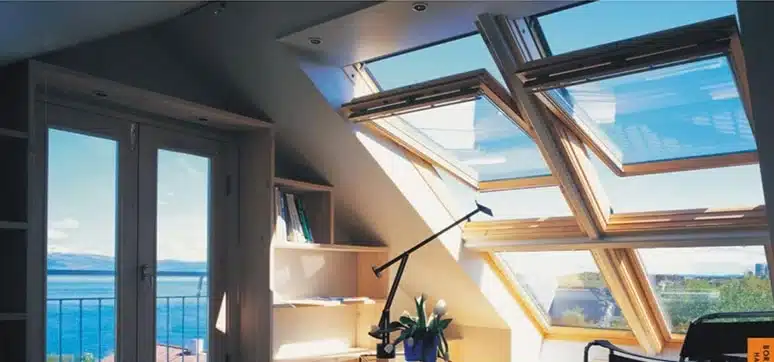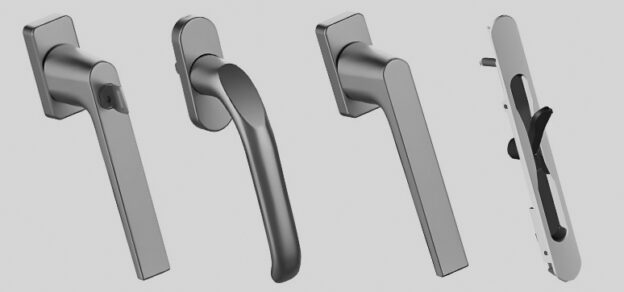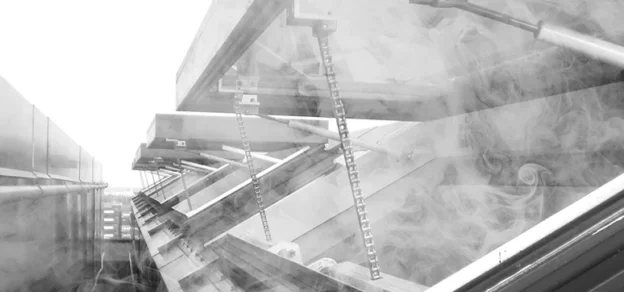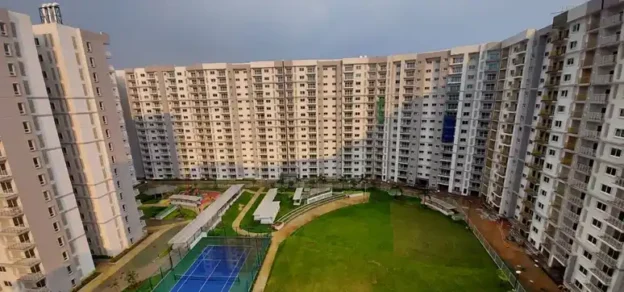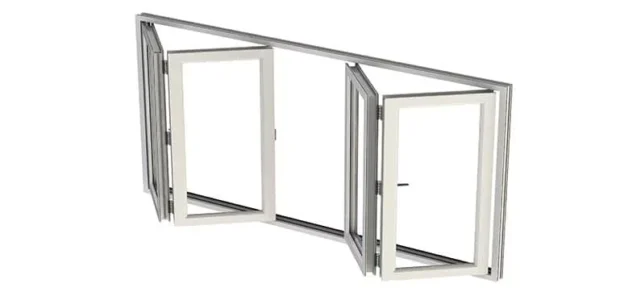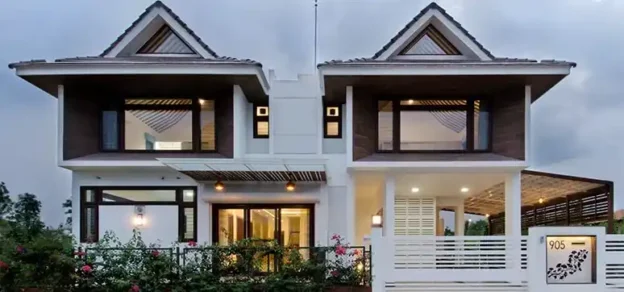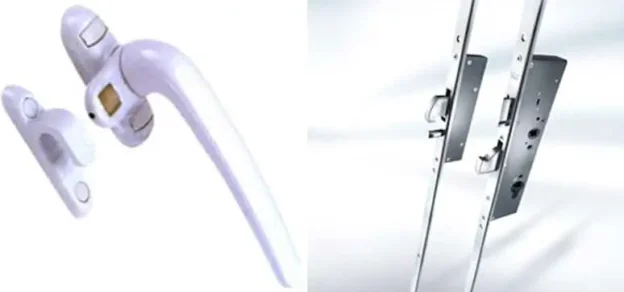A key component of building design is the selection and application of hardware in fenestration and architectural façade systems. The energy efficiency of a structure is significantly influenced by the façades and fenestrations, which act as the first line of defence against external elements. And therefore hardware plays an important role in that. The type of material utilised in the hardware, such as aluminium or stainless steel, is an important factor. Thus, the hardware must be able to survive a variety of weather conditions, especially high winds and heavy rain.
The ease of installation & maintenance, compatibility with the rest of the construction materials, and adherence to local building norms and laws are additional crucial factors and criteria for the selection of hardware. The proper selection and application of hardware can improve the aesthetic appeal, functionality, and durability of a building’s façade and fenestration systems.
Below are a few important parameters and criteria for the selection and applications of hardware in terms of its efficiency and safety:

1. Safety and Security: Hardware for fenestration must be chosen with safety and security in mind. The hardware should be designed to provide optimal safety and security for building occupants. It must have the capability of being able to withstand forceful entry, stop unauthorised access, and offer protection from environmental dangers including wind, rain, and seismic activity.

It is essential to choose hardware that complies with industry standards and laws in order to assure safety and security. Extreme weather resistance, impact resistance, and other properties of the hardware should be checked. The device should also be simple to use and give users clear instructions.
2. Accessibility: While selecting architectural elements/devices, accessibility is a major factor. All users of the building, including those who are disabled, should be able to easily access devices, handles, and operating gadgets. The hardware ought to be simple to use, even for people with weak or limited physical capabilities. In addition, the hardware must abide by accessibility laws such as the Americans with Disabilities Act (ADA).
Hardware needs to be selected to fit the demands and capabilities of the building’s residents in order to provide accessibility. Clear instructions and simple controls should be present on the operating handles, which should also be simple to access and use.
 3. Performance: Performance is the next vital criterion for hardware selection in architectural façade windows and fenestration systems. It describes the hardware’s capacity to carry out its intended function effectively and efficiently. This covers elements like operability and safety, as well as acoustic and thermal insulation.
3. Performance: Performance is the next vital criterion for hardware selection in architectural façade windows and fenestration systems. It describes the hardware’s capacity to carry out its intended function effectively and efficiently. This covers elements like operability and safety, as well as acoustic and thermal insulation.
High-performance hardware can improve a building’s comfort, safety, and energy efficiency. All weather conditions should not hinder the hardware’s ability to function effectively and dependably while still offering sufficient security and insulation. Thus, it is of the utmost importance to take into account the hardware’s functionality and impact on the comfort and use of the building.
4. Maintenance: In architectural façade windows and fenestration systems, maintenance is an important issue for hardware selection. It speaks to how simple it is to clean, lubricate, and adjust the hardware as well as to repair and maintain it. With readily available parts and simple instructions, the hardware should be simple to maintain and repair. Poorly maintained hardware can cause performance issues, safety risks, and air or water ingress.

The lifespan of the hardware can be increased and its best performance can be guaranteed with routine maintenance. So, before making a purchase, it’s important to think about the hardware’s maintenance requirements. It is feasible to lower the costs of repairs and replacements while assuring optimal performance by choosing hardware that is simple to maintain.

5. Durability: Durability is also an important variable to take into account when choosing fenestration hardware. The hardware must be resistant to deterioration, corrosion, and environmental elements including moisture and temperature variations.
It must have to be able to keep running at its maximum productivity for a protracted period of time without endangering the building’s security or functionality. It is vital to choose hardware that has undergone thorough testing and is built of high-quality materials to ensure durability. The hardware needs to be examined to see if it can endure heavy usage, harsh weather, and corrosive elements.
 6. Compatibility: For architectural façade windows and fenestration systems, compatibility is a crucial factor that needs to be taken into consideration. It refers to the hardware’s capacity for seamless integration with the current façade system and other elements, such as glazing, frame, and sealing materials. In order to prevent any problems, it is crucial to evaluate how well the hardware works with the current system and components. Selecting incompatible hardware might result in performance and energy loss as well as air or water infiltration. Thus, it is essential to thoroughly assess the hardware compatibility before making a purchase.
6. Compatibility: For architectural façade windows and fenestration systems, compatibility is a crucial factor that needs to be taken into consideration. It refers to the hardware’s capacity for seamless integration with the current façade system and other elements, such as glazing, frame, and sealing materials. In order to prevent any problems, it is crucial to evaluate how well the hardware works with the current system and components. Selecting incompatible hardware might result in performance and energy loss as well as air or water infiltration. Thus, it is essential to thoroughly assess the hardware compatibility before making a purchase.
7. User-Friendly: Whenever picking fenestration hardware, usability is a key factor to take it in the process of selection. Even people who are unfamiliar with the system should find it simple to use the hardware & operable devices. In order to reduce the danger of user mistakes, the hardware should have simple operations, clear instructions, and intuitive controls. By lowering the possibility of mishaps & breakdowns, user-friendly technology can improve the building’s safety & functionality. It’s essential to think about the requirements and skills of the building’s users & choose hardware that satisfies those requirements to ensure user-friendliness. It should also be simple to install, maintain, and repair the hardware. Reduce the possibility of harm or malfunction with clear instructions & accessible parts.
 8. Cost: While choosing hardware for architectural façade windows and fenestration systems, the cost is an important aspect that must be taken into consideration. It covers the cost of the initial purchase as well as continuing repairs and operating expenses. The gear needs to be affordable and provide good value. However, the cost should not compromise the quality or performance of the hardware. It is necessary to take into account the hardware’s long-term costs, including energy usage, durability, and maintenance requirements. It is feasible to choose hardware that offers the needed performance and functionality while being cost-effective by taking price into account.
8. Cost: While choosing hardware for architectural façade windows and fenestration systems, the cost is an important aspect that must be taken into consideration. It covers the cost of the initial purchase as well as continuing repairs and operating expenses. The gear needs to be affordable and provide good value. However, the cost should not compromise the quality or performance of the hardware. It is necessary to take into account the hardware’s long-term costs, including energy usage, durability, and maintenance requirements. It is feasible to choose hardware that offers the needed performance and functionality while being cost-effective by taking price into account.
9. Aesthetic & Appearance: It’s significant to take the hardware’s aesthetics and look when choosing fenestration hardware. The hardware should fit the architectural style and design of the structure, be made of materials that go well with the exterior and have finishes that go well with the environment surroundings and colour palette. In addition to having the right scale and proportion with respect to the building’s façade, consistency in design and quality is also important. Its look can also be affected by how the hardware is installed and where it is placed. Building owners and architects can choose hardware that not only fits their practical needs but also raises the value and appeal of the framework by taking into account the hardware’s aesthetics and appearance along with safety, functionality, and longevity. The hardware plays a vital role in creating a cohesive and harmonious look for the building’s façade.
Last but not least, it is essential to collaborate with knowledgeable experts in the fields of architectural design and construction to guarantee that the choice and application of hardware fit the unique objectives and specifications of the building project. They can guide you through local building standards and regulations and offer insightful information on the most recent hardware innovations and materials.
In conclusion, the performance, security, and general aesthetic appeal of a structure is significantly influenced by the choice and use of hardware in architectural façade and fenestration systems. When choosing hardware, it is extremely important to take into careful consideration a number of aspects like the material, weather resistance, security, price, and compliance. By doing this, one may make sure that the building’s façades and fenestrations are as durable, useful, and energy-efficient as possible.
The 25 South Tower Prabhadevi, Mumbai

The 25 South Tower is a high-rise residential building located in Prabhadevi, Mumbai. The tower boasts more than 50+ floors, including ten podiums, three service floors, and a penthouse that occupies the top three floors. The project features a unique combination of toggle curtain wall systems, sliding windows with integrated railing, and casement windows which include side hung, top hung & tilt-n-turn. The penthouse of the building is designed with jumbo glass panels of lift and slide thermal break doors with multiple tracks and panels, which connect the open balcony and the internal lounge area.
The design of the penthouse’s curtain wall was particularly complex and unique, requiring careful planning, coordination, and execution between the façade manufacturer, architects, and contractors. The façade integrates a bespoke sliding system with the toggle curtain wall, making the mullions and transoms of the façade serve as the sliding track system for the windows. This feature is an innovative design that adds aesthetic appeal and improves functionality, energy efficiency, and occupant comfort.
One of the significant challenges of the project was to ensure that the hardware used in the bespoke sliding curtain wall met all the selection criteria and application requirements. The creative and innovative design team used existing hardware from developed systems and integrate them seamlessly into the design of the bespoke system.
To achieve this, the design team had to conduct a thorough analysis of the existing systems and hardware to identify the appropriate components that could be integrated into the bespoke sliding curtain wall design. They also had to consider the performance criteria, such as strength, durability, and weather resistance, of the existing hardware to ensure that it would meet the requirements of the new design.

The team had to work closely together to ensure that the hardware used in the curtain wall met all the requirements of the design while also maintaining its functionality and aesthetic appeal. In conclusion, the successful integration of existing hardware into the design of the 25 South Tower’s penthouse curtain wall is a remarkable achievement. The project required a high degree of precision and attention to detail to ensure that the hardware met all the selection criteria and application requirements. The result is a beautiful and functional façade that enhances the building’s aesthetic appeal and provides improved functionality, energy efficiency, and occupant comfort.
QUICK FACTS:
• Project: 25 South
• Location: Prabhadevi, Mumbai
• Client: Hubtown
• Architect: Architect Hafeez Contractor
• Other Consultants: Axis/Avante Façade Consultants
• Architectural Hardware used: Alumil Systems & Hardware, Roller, Locking Devices, Handle & Accessories for Sliding Doors/Windows, Friction Hinges, Limit Arm, Butt Hinges, Locking Devices, Handles & Accessories for Side/Top Hung Window.
• Commencement Date: 2015
• Completion Date: 2023 (Not Confirmed)
The Tower at PNC Plaza Pittsburgh, The United States

The Tower at PNC Plaza is a 33-story corporate headquarters located in downtown Pittsburgh. It was designed by Gensler and its partners with the goal of revitalising the area while setting a new standard for sustainable skyscrapers. The building is LEED Platinum-certified, and its unique design features a double-skin façade, two vertical thermal shafts, and a solar chimney that naturally ventilates the building for more than 40 per cent of the year, without the use of electricity or fan power.
The building consumes up to 50 per cent less temperature-control-related energy than comparable buildings of its size. Gensler and their team followed the Three Pillars – workplace innovation, energy response, and community building – in the design process. The Tower’s façade is the most defining feature of the building, serving as breathable skin and facilitating natural ventilation in a passive manner.

The double-skin façade design of The Tower at PNC Plaza is made up of slim, vertical translucent glass panels that resemble boat sails. The panels can open on good weather days, letting fresh air come in from the lower windows while warm air goes out through the top. The diagonal pattern of the panels stops the warm air from coming back into the building on the next floor, and this cools the building naturally. This design looks cool and also helps to save energy by allowing natural ventilation instead of relying on air conditioning.
The poppers and floppers in The Tower at PNC Plaza are ground-breaking innovations in the field of sustainable building design. The poppers, which are located in the exterior skin of the double-skin façade, are air gates that allow fresh air to enter the building. There are 557 poppers in total, each measuring about 16 inches wide and 12 feet high. These poppers open automatically in response to sensors that detect weather conditions, such as temperature, sun path, weather conditions, and wind. This allows the building to regulate its interior temperature and maintain a comfortable environment for occupants.

The floppers, on the other hand, are located in the interior skin of the double-skin façade. They are automated louvers that allow for natural ventilation. Like the poppers, the floppers open and close automatically in response to sensors that detect weather conditions. The movement of both the poppers and floppers is controlled by programmatic electric actuators & air vents respectively, which ensure precise and efficient operation.
The double-skin façade of the Tower at PNC Plaza provides insulation and aids in natural ventilation by creating a 30-inch-wide hollow space between the exterior and interior skins. This space allows fresh air from the poppers to pass through the floppers located at the floor level of the inside skin. The fresh air then moves past occupants and equipment, acquiring their heat, before being expelled through vents in the solar chimney at the centre of the building. The design of the workstations allows the incoming fresh air to pass easily beneath them.
WindowMaster manufactured and delivered more than 6300 actuators to control 557 parallel windows in the outer double skin façade and 1450 automated air vents in the inner façade. The main reason for choosing WindowMaster as a supplier for this project is the large amount of quantity and MotorLink technology that enables genuine synchronisation of four actuators on one parallel window and exact position control and feedback via the BACnet BMS. MotorLink is a communication technology that enables 2-way control and feedback between window actuators and the Building Management System via the motor controller
In conclusion, the Tower at PNC Plaza showcases the significant role of innovative hardware in sustainable building design. The poppers and floppers, along with the MotorLink technology-enabled WindowMaster actuators, are critical components that ensure the precise & efficient operation of the building’s natural ventilation system. The double-skin façade, consisting of slim, vertical translucent glass panels, serves as a breathable skin that allows for natural ventilation and insulation, contributing to the building’s energy efficiency. The Tower at PNC Plaza is a prime example of how innovative hardware can play a crucial role in creating sustainable buildings that set new standards for the industry.

QUICK FACTS:
• Project: The Tower at PNC Plaza
• Location: Pittsburgh, US
• Client: PNC Financial Services Group
• Architect: Gensler
• Other Consultants: Buro Happold, Heintges & Paladino
• Architectural Hardware used: WindowMaster, Permasteelisa Group & SAPA Actuators & Air Vents, Temperature, Wind, Sun Path & Weather Condition Sensors, Parallel Opening Friction Hinges & Accessories for Parallel Openings, Roller, Locking Devices, Handle & Accessories for Manual Sliding Doors
• Commencement Date: 2012
• Completion Date: 2015
